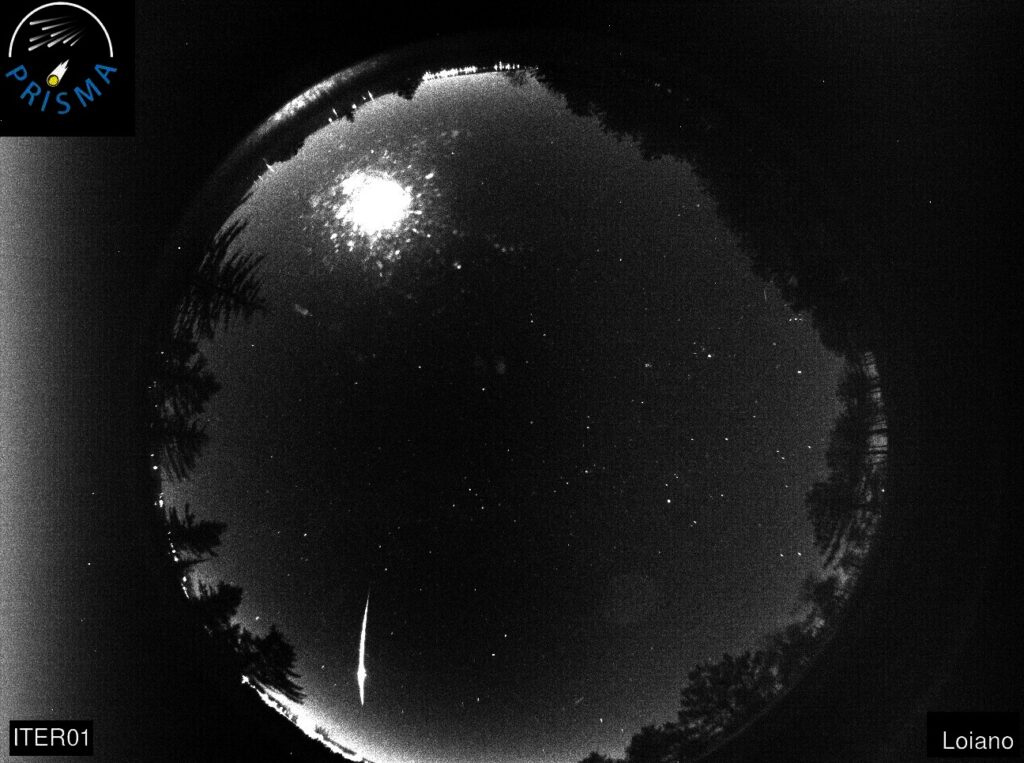Our planet is subjected to the daily “bombardment” of small meteoroids, i.e. fragments of the large population of near-Earth asteroids in the middle of which the Earth moves while describing its heliocentric orbit. Meteoroids hit the Earth’s atmosphere with a typical speed of 20 km/s (the possible range of speeds is from 11.2 to 72 km/s), and begin to dissipate their kinetic energy rapidly losing their cosmic speed. A shock wave develops in the front of the meteoroid in which atmospheric gases are compressed and heated up to temperatures of the order of 2500 K: a high-temperature plasma bubble is generated, surrounds the meteoroid and consumes it as it falls towards the ground.

The fireball of January 1, 2020, taken from the PRISMA station in Loiano.
The plasma bubble also emits visible radiation, so the fall phases can be seen even from hundreds of kilometres away. Events of this type are called “fireballs“, while the more energetic ones, caused by meteoroids a few meters in diameter and visible even during the day, are “superbolids“. Small fireballs are much more numerous than more energetic events. It is estimated that a fireball of absolute magnitude -5 (meteoroid diameter about 10 cm) occurs every few minutes somewhere on Earth, a fireball of -9 has a weekly frequency (diameter of a few tens of cm), a fireball of – 13 at least once a year. The analysis of a fireball is divided into 4 phases:
- Triangulation: Different all-sky stations are used to reconstruct the average trajectory of the fireball in the atmosphere.
- Meteoroid dynamic model: The physical parameters that describe the meteoroid are obtained starting from the altitudes and velocities observed in the atmosphere.
- Dark-flight: Starting from the observed final point, knowing the final altitude, speed and acceleration, the free fall is modelled to obtain the area on the ground where to look for any meteorites (strewn field).
- Orbit: Starting from the dynamic model of the meteoroid, the speed to infinity outside the atmosphere is obtained. From this we can derive the heliocentric speed of the meteoroid and, knowing the position of the Earth in space at the time of the fall, we compute the heliocentric orbit of the meteoroid.
The PRISMA project (Prima Rete per la Sorveglianza sistematica di Meteore e Atmosfera, i.e. First Network for the Systematic Surveillance of Meteors and Atmosphere) coordinated by INAF, is an Italian network of about 50 all-sky cameras dedicated to the observation of fireballs to determine the heliocentric orbits of the meteoroids that generate them and delimit – with a reasonable degree of approximation – the areas of possible falling fragments to be able to recover the meteorites. The PRISMA network is associated with the similar French network FRIPON. The PRISMA project involves researchers from the National Institute of Astrophysics and universities, amateur astronomy groups, regional or municipal astronomical and meteorological observatories and schools.
The OAS contribution to PRISMA
The OAS has its own PRISMA camera located on the roof of the guesthouse of the Loiano station and plays a leading role in the PRISMA collaboration. MuFiS, Multipurpose Fireball Software, was developed in OAS, and used for the triangulation of the fireball trajectory, the computation of the dark flight phase and the ground delimitation of the falling field of the meteoroid fragments (strewn field). The PRISMA project has already successfully recovered a pair of meteorites with a total mass of 52 grams in Cavezzo, near Modena (Italy), associated with the fireball of January 1, 2020, and captured by 8 chambers of the PRISMA network. A recovery of meteorites following the triangulation of the fireball is the first time this has happened in Italy. A second meteorite with a total mass of 117 grams was recovered near Matera on February 17, 2023, associated with a fireball observed by three Prisma chambers on February 14, 2023.
